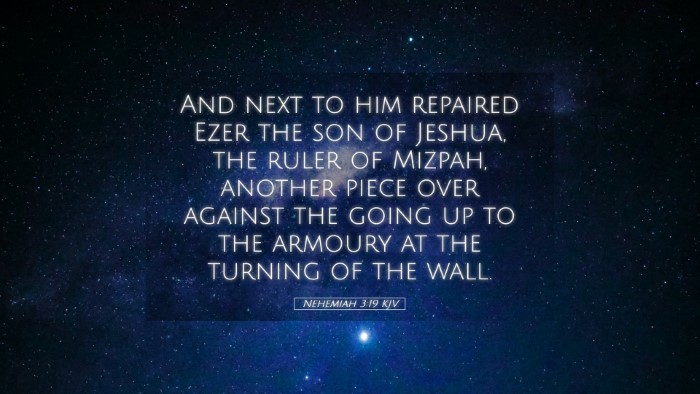Commentary on Nehemiah 3:19
Nehemiah 3:19 states:
"And next to him repaired Ezer the son of Jeshua, the ruler of Mizpah, another piece, over against the going up to the armory at the turning of the wall."
Context and Structure
This verse serves as part of the broader account of the rebuilding of the walls of Jerusalem, which is a crucial theme throughout the book of Nehemiah. In chapter 3, we find a detailed account of the various individuals and groups engaged in the restoration efforts, depicting a community unified in purpose.
Key Insights from Public Domain Commentaries
Matthew Henry's Commentary
Matter of Unity and Cooperation: Henry emphasizes the communal aspect of the rebuilding process. Ezer, being a ruler of Mizpah, highlights the involvement of leaders in rebuilding, enhancing the sense of collective effort and responsibility. Each worker contributed their skills and labor, suggesting that rebuilding God’s house requires communal participation.
Symbolism of the Armory: The mention of the armory signifies readiness for defense. As Nehemiah and his companions undertook the daunting task of reconstruction, they were not just building walls but fortifying the city against potential adversaries. Henry notes a spiritual parallel here: rebuilding one’s spiritual life involves preparation against temptation and sin.
Albert Barnes' Notes
Loyalty and Leadership: According to Barnes, the involvement of Ezer signifies the importance of leadership in community efforts. Ezer's participation demonstrates that leaders must actively engage in rebuilding efforts, setting an example for others to follow. His name being associated with this particular section of the wall epitomizes the weight of responsibility upon leaders.
Geographical Note: Barnes also provides insight on the geographical significance of Mizpah as a strategic location, hinting at the historical context in which these events took place. The armory being adjacent to Ezer’s work indicates a strategic fortification that acknowledges the dangers surrounding Jerusalem at that time.
Adam Clarke's Commentary
The Purpose of the Armory: Clarke elaborates on the functional aspects of the armory mentioned in this verse. It served as a crucial point for the armament of the people, suggesting that spiritual vigilance is as important as physical protection. This duality highlights the necessity of preparation in all areas of life.
Spiritual Application: Clarke draws upon this verse to illustrate that spiritual leaders need to hold their ground and maintain vigilance for their communities. The act of rebuilding is not merely a physical act but also a representation of the restoration of faith and commitment within the community.
Interpretative Themes
- Community and Leadership: Nehemiah’s account is heavily focused on building community and leadership. Each individual named represents the importance of involvement and dedication.
- Spiritual Warfare: The context surrounding the armory reminds readers of the spiritual warfare faced by the church today. Just as Nehemiah’s generation rebuilt walls, contemporary believers must build and defend their faith actively.
- Historical Context: Understanding the significance of the locations mentioned elucidates the text's historical context and allows for a deeper understanding of the challenges faced by the returnees from Babylon.
Conclusion
Nehemiah 3:19 symbolizes more than just a moment in history; it reflects the broader themes of leadership, community effort, spiritual vigilance, and the sacred task of rebuilding. Insights from Matthew Henry, Albert Barnes, and Adam Clarke enrich our understanding of this verse, reminding us of our responsibilities in both spiritual and physical realms. Such reflections on this passage challenge pastors, students, theologians, and scholars to consider their engagement in the continual process of community rebuilding and spiritual fortification.


